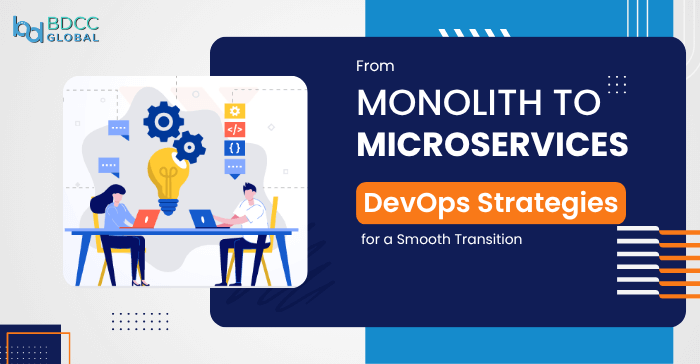
Modern software systems demand flexibility, faster release cycles, and scalability. But if your application is still running on a monolithic architecture, those goals can feel difficult to reach. That’s why many organizations are now moving toward microservices—a software design approach where applications are broken down into smaller, independent services that work together.
However, making this shift is far from simple. It involves not just technical changes, but also adopting the right DevOps strategies to support a smooth and reliable transition. In this blog, we’ll explore what this transition means, why it’s becoming essential for growing businesses, and how DevOps plays a critical role in making the shift manageable and scalable.
This is your complete guide to understanding the monolith to microservices transition, and how to modernize your application infrastructure the smart way.
What is a monolithic application?
A monolithic application is built as a single, unified codebase. All components—user interface, business logic, data access layer—are interconnected and run as one large program.
Monoliths are:
- Easier to build in the early stages
- Straightforward to deploy as there’s only one codebase
- But harder to maintain and scale as the application grows
Over time, even minor changes can require large portions of the system to be redeployed or retested. This slows down development, increases risk, and leads to technical debt.
What are microservices?
Microservices architecture breaks down an application into independent services. Each service represents a small piece of functionality—such as user authentication, billing, or product catalog—and can be developed, deployed, and scaled independently.
These services typically:
- Communicate via APIs
- Have their own databases or data layers
- Can be deployed in isolation without affecting other services
This flexibility is why companies modernizing their systems are increasingly migrating to microservices.
Why migrate from monolith to microservices?
The transition from monolithic to microservices architecture is often driven by the need for scalability, agility, and resilience. Here are a few common reasons organizations make the shift:
- Independent scaling: Scale only the parts of your system that require it, saving resources.
- Faster deployments: Individual services can be released without coordinating a large, risky deployment.
- Team autonomy: Teams can own and manage their services without stepping on each other’s toes.
- Technology diversity: Different services can use different stacks, as long as they communicate properly.
This process is a critical part of application modernization, especially for growing businesses or platforms reaching architectural limits.
The role of DevOps in microservices migration
As systems become more complex with microservices, the need for automation, monitoring, and collaboration becomes stronger. That’s where DevOps comes in.
DevOps is a set of practices that combines software development (Dev) and IT operations (Ops). It emphasizes:
- Automation of builds, tests, and deployments
- Continuous Integration and Continuous Delivery (CI/CD)
- Infrastructure as Code (IaC)
- Monitoring and observability
- Team collaboration and shared responsibility
These principles make DevOps architecture a natural match for microservices. Without DevOps, managing dozens of services, each with its own dependencies and deployment cycles, can quickly become unmanageable.
Step-by-step transitioning from monolith to microservices
-
Analyze your monolith
Start by identifying which parts of your monolith can be decoupled. Focus on domains or modules that are well-defined and loosely connected to others—these make the best candidates for early extraction.
Ask questions like:
- What are the performance bottlenecks?
- What features change most frequently?
- Which parts of the application can logically stand alone?
This analysis sets the foundation for a clean and safe refactoring of monolithic apps.
-
Prepare your DevOps pipeline
Before extracting services, make sure your DevOps setup is ready. That means:
- Creating CI/CD pipelines for individual services
- Automating tests for each stage of the pipeline
- Containerizing services using Docker or similar tools
- Using Kubernetes or another orchestration tool for deployment
- Setting up centralized logging, monitoring, and alerting
This is the foundation of a reliable DevOps microservices environment.
-
Define your microservices boundaries
Use techniques like domain-driven design (DDD) to clearly define the boundaries of each service. Each service should be responsible for one specific function and own its data.
Decide early on:
- How services will communicate (REST, GraphQL, gRPC)
- What API contracts they’ll follow
- How you’ll manage authentication and authorization across services
A strong boundary makes your microservices easier to scale, test, and maintain.
-
Migrate gradually using proven patterns
One of the most recommended approaches is the Strangler Fig pattern. In this method, new functionality is built as microservices, while the old monolith continues to run. Over time, existing features are refactored and moved into services, “strangling” the monolith.
This reduces risk and keeps your application running smoothly while migration is in progress.
-
Build for observability
With more services come more moving parts. Observability is key to managing them effectively.
Your DevOps team should implement:
- Centralized logging for tracking issues across services
- Monitoring tools to measure performance and uptime
- Distributed tracing to understand how requests move across services
This ensures you’re not flying blind as you scale.
Challenges to expect in the transition
Moving from monolith to microservices isn’t just technical—it affects culture, workflows, and team structures. Here are a few common challenges:
- Increased complexity: More services mean more systems to manage.
- Data management: Migrating to separate databases requires careful planning.
- Cross-service communication: Failing APIs can bring down key parts of the app.
- Team readiness: Developers and Ops teams must adapt to a new way of working.
These challenges are real, but solvable—especially when you pair smart planning with strong DevOps architecture.
Best practices for DevOps-driven microservices migration
- Start small: Choose a low-risk module for your first service.
- Automate everything: From deployment to monitoring, automation is your ally.
- Use containers: Tools like Docker make packaging services more consistent.
- Promote ownership: Let teams own specific services end-to-end.
- Communicate clearly: As services grow, documentation and internal APIs must be well maintained.
Transition with purpose, not just pressure
Adopting microservices isn’t just about following a trend. It’s a strategic decision that supports growth, innovation, and long-term sustainability.
A successful monolith to microservices transition requires:
- Clear service boundaries
- Gradual refactoring
- Well-prepared DevOps pipelines
- Consistent communication and testing
- Cultural readiness across teams
By applying DevOps microservices principles from the start, you’ll avoid common pitfalls and set yourself up for a smooth, scalable modernization journey.
Need help planning your transition?
We help businesses modernize their legacy systems with DevOps-first approaches and scalable architectures. Whether you’re in early planning or mid-transition, our team can help you refactor, automate, and scale with confidence.
Talk to our experts about your microservices roadmap.

